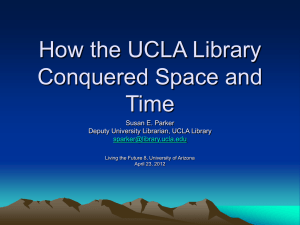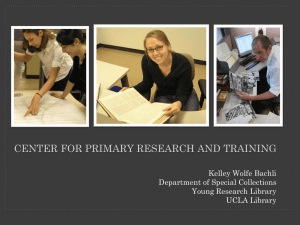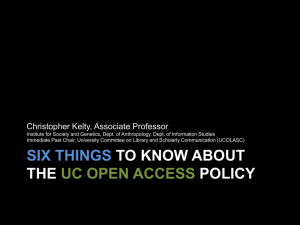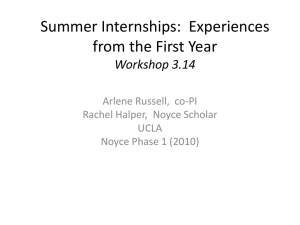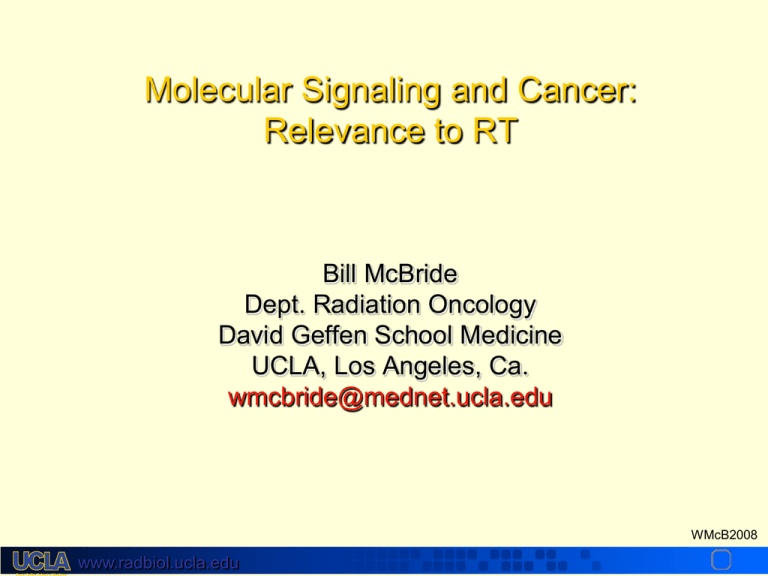
Molecular Signaling and Cancer:
Relevance to RT
Bill McBride
Dept. Radiation Oncology
David Geffen School Medicine
UCLA, Los Angeles, Ca.
wmcbride@mednet.ucla.edu
WMcB2008
www.radbiol.ucla.edu
Objectives:
• Know how ligands work through receptors to
activate phosphorylation /dephosphorylation
reactions leading to gene transcription
• Know how dysregulation of these pathways
leads to cancer
• Know how radiation-induced signal transduction
pathways intersect with those altered in cancer
to affect intrinsic radiosensitivity
WMcB2008
www.radbiol.ucla.edu
Signaling
• Signal transduction evolved to allow single cells to respond to their
extracellular environment.
• It became more sophisticated as metazoans needed mechanisms
to allow
– communication between cells within tissues and between
tissues to allow
•
•
•
•
morphogenesis
wound healing,
recognition and elimination of microbes,
maintenance of homeostasis.
WMcB2008
www.radbiol.ucla.edu
Types of Signals
• External microenvironmental physiological signals
• Adjacent cells, extracellular matrix, cytokines and growth factors,
hormones, glucose, amino acids, ions, etc.
• External microenvironmental pathological signals
• Danger-associated molecular patterns (DAMPs)
• Pathogen-associated molecular patterns (PAMPs)
• Inflammatory and immune cells
• Internal homeostatic signals
• Response to DNA and mitochondrial damage, ROS, hypoxia,
metabolism, etc.
• Most signals are sent through ligand binding to specific cell-surface
receptors, allowing multiple extracellular stimuli to be distinguished
WMcB2008
www.radbiol.ucla.edu
Multiple Signaling Pathways are Integrated to
Make a Response
Peptide hormones
Odorants
Chemoattractants
Neurotransmitters
Taste Ligands
G-proteinR
Growth Factors
Lipid kinases
Protein kinase R
Tumor necrosis
Factor family
Cytokines
Steroid R
Cadherins
GTP GDP
Integrins
TNFR
family
CytokineR
Hormones
Nucleus
GlucoseR/
Ion channels
Extracellular
matrix
Pathogen
Associated
Toll-likeR Molecular Patterns
(PAMPs)
Damage
Associated
Molecular Patterns
(DAMPs)
Nucleus
• Multiple signals are integrated to generate an appropriate biological
response, whether it be cell death/ survival, cell cycle arrest/ progression,
glycolysis/aerobic metabolism, DNA repair/stability
• Signaling pathways affect radiation responses
• Radiation IS a signal
www.radbiol.ucla.edu
WMcB2008
The Initial Step is Receptor Activation by LigandInduced Oligomerization
Inactive Receptors
RTK (EGFR, PDGFR)
Activated Receptors
Cytokine Receptor
ATP
autophosphorylation
ADP
• leads to activation of receptor kinases or conformational changes that
allow adapter proteins that bind to activate cascades
• Receptors can co-associate with others to synergize eg ErbB1 and 3 may be important in cancer escape from targeting
WMcB2008
www.radbiol.ucla.edu
Signals Change mRNA and Protein
Levels
• Transcriptional activation
• Post-transcriptional mRNA stabilization
– AU rich UTRs
• Translational control mechanisms
• Post-translational protein destabilization and stabilization
– phosphorylation, ubiquitination, acetylation, oxidation, nitrosylation
•
Protein degradation
– Stabilization of mRNA and protein expression allow rapid
responses - immediate early genes - fos, jun, GM-CSF,
TNF-, p53, IkB, etc.
IR can cause ALL of these!
WMcB2008
www.radbiol.ucla.edu
Major Players - Kinases
• Tyrosine kinases (100 genes)
– Growth Factor Receptors (RTKs; 60 genes)
– Cytoplasmic (35-40 genes) Jak, Src, Fak, Tec…
• Serine/threonine kinases (400 genes)
– MAP Kinases, TGF-R, PKC, ATM
• Dual specificity kinases
– MEK
Phosphatases (eg PTEN, CDC25) control phosphorylation.
WMcB2008
www.radbiol.ucla.edu
A Few Examples - RTKs
•
Epidermal Growth Factor
Receptor family
• erbB1 (c-erbB)
• erbB2 (neu)
• erbB3
• erbB4
•
Fibroblast Growth Factor
Receptor family
• FGFR-1(fig)
• FGFR-2(K-sam)
•
Platelet Derived Growth Factor
Receptor family
• CSF-1R (c-fms)
• SLF R (c-kit)
•
•
Insulin Growth Factor Receptor
Family
– IGFR-1 (c-ros)
Neurotrophins
– NGFR (trk-A)
– BDNFR (trk-B)
– NT3 R (trk-C)
WMcB2008
www.radbiol.ucla.edu
Phosphorylation
• Alters activity of enzymes initiating cascades
• eg MAP kinase pathway initiated by activation of EGFR
by auto-phosphorylation.
• Induces DNA binding
• STAT and c-jun transcriptional activities
• Changes subcellular localization of proteins
• e.g. recruitment of adaptor to activated receptors,
nuclear localization of hormone receptors
• Changes protein stability
• phosphorylation leads to degradation or stabilization p27, IkB, p53, etc .
WMcB2008
www.radbiol.ucla.edu
Molecular Features of Cancer
Mutations in molecular signaling pathways leading to
• Self-sufficiency in growth factor signaling (ligands or
receptors)
• Loss of response to anti-proliferative signals
• Evasion of programmed cell death
• Increase in replicative potential (telomeres)
• Promotion of tissue invasion and metastasis
• Sustained angiogenesis
• Amplified by DNA repair abnormalities and genomic
instability
Hanahan D, Weinberg RA, Cell 57-70, 2000.
Overall decrease in cell loss factor
WMcB2008
www.radbiol.ucla.edu
• “Driver” mutations in protooncogenes give
oncogenes that generally cause gain in
function.
• Tumor suppressor genes are the “brakes”.
Mutations in these cause loss of function and
generally both alleles need to be affected.
• Activated oncogenes and loss of tumor
suppressor genes cause replication stress and
increased DNA damage, which results in tumor
progression
WMcB2008
www.radbiol.ucla.edu
• Tumor cells become “addicted” to the mutated molecules and
pathways they need for their existence
– This is good news because targeting these critical molecules can
have dramatic consequences
– The bad news is that the mutation rates often allow variants to
escape
• Although the steady state of the tissue cells is disturbed, there is
still a lot of cell loss.
– Cancer stem cells exist that may be a small minority of the
population. They may not be the targeted by the chosen therapy.
Rapid tumor regression may not mean much if it represents loss of
the non-stem cell population
– Cancer stem cells are responsible for tumor regrowth and treatment
failure
WMcB2008
www.radbiol.ucla.edu
Oncogenes
• The first oncogene (src) was discovered in 1970 in a chicken
retrovirus. In 1976, Bishop and Varmus demonstrated that oncogenes
were defective proto-oncogenes that coded for normal growth and
differentiation proteins (‘the enemy within”), for which they received
the Nobel Prize in 1989.
• Oncogenes are “driver” mutations that encode
–
–
–
–
–
–
–
Receptor/cytoplasmic tyrosine kinases (EGFR, PDGFR, Ras/MAPK)
Ser/thr kinases (AKT, mTOR)
Lipid kinases (PI-3K)
Transcription factors (c-MYC, STATs, c-JUN, c-FOS)
Cyclins/CDKs (Cyclin D)
Regulators of protein stability (MDM2)
Anti-apoptotic factors (BCL-2, BCL-XL)
• They gain function by
–
–
–
–
–
Domain deletion (EGFRvIII, Her2)
Point mutation (Ras)
Translocation (BCR-Abl, Myc)
Altered subcellular localization (BCR-Abl)
Gene amplification (Myc, EGFR, Her2)
WMcB2008
www.radbiol.ucla.edu
Oncogenic Mutations in Cancer
H-Ras K-Ras
N-Ras Neu
EGFR
Increased expression
Myc
K-Ras
Myb
RelA
EGFR
int-1
int-2
mos
Altered protein
Amplification
Point mutation
Insertion
Protooncogene
Translocation
Deletion
Normal
protein
Altered Protein
Abl, Trk
Increased expression
C-Myc, Bcl-2
Altered protein
EGFR, (ERB-B1), NF-B
WMcB2008
www.radbiol.ucla.edu
Philadelphia Chromosome
Bcr (160KDa)
(Breakpoint cluster region)
OLI
Abl (140KDa)
Bcr-Abl
ALL (190KDa)
CML (210KDa/230 KDa)
OLI
Nowell and Hungerford (1960)
t(9;22)(q34;q11)
CML - 95%
ALL, 25-30% in adult and 2-10% in pediatrics
Abnormal signaling and localization
JAK1/2
Crk-L
Grb2
PI-3 kinase
Sos
Ras
ERK1/2
www.radbiol.ucla.edu
Akt
STAT3
STAT5
Cyclin D1,D2,D3
Bcl-xL
WMcB2008
Imatinib/Gleevec/STI571
• Druker, Sawyers and Talpaz showed that Gleevec inhibits proliferation of CML
• Inhibits Abl by binding to the ATP-binding site in the kinase domain
• Relapse as a result of the outgrowth of leukemic subclones with resistant BCRABL mutations - treated with dasatinib
WMcB2008
www.radbiol.ucla.edu
Myc-induced Oncogenesis
1
MB I
MB II
143
355 366
Myc
407 413
HLH
Transactivation Domains
1
MB= Myc Boxes
BR= Basic Region
HLH= Helix-Loop-Helix
LZ= Leucine Zipper
Max
434
LZ
DNA Binding and oligomerization
151
HLH
LZ
Mechanisms of oncogenic activation
• 70% of cancers have deregulated Myc
• Chromosomal translocations increase c-Myc transcription
(Burkitt’s lymphoma and other lymphoid malignancies)
• Gene amplification (AML, lung, breast, colon, brain, prostate)
• Point mutations increase transactivation function (breast, ovarian,
colon)
WMcB2008
www.radbiol.ucla.edu
C-myc Translocations in Cancer
C-Myc
gene
,l,m loci
P1
P2
t(8;14)
J Ei
P1
Cm
C1
P2
t(2;8)
MAREi C
Translocation
P1
P2
t(8;22)
Cl
El
• Translocations link the c-Myc gene to a region of transcriptionally active DNA
• This increases c-Myc expression levels and induces aberrant proliferation
• In contrast to BCR-Abl, c-Myc translocations DO NOT alter the protein structure; they
increase expression levels of the WT gene and protein
WMcB2008
www.radbiol.ucla.edu
C-Myc translocations and disease
Translocation
Genes
Disease
t(8;14)(q24;q32)
c-myc/IgH
Burkitt’s lymphoma
t(2;8)(p12;q24)
Ig/c-myc
Burkitt’s lymphoma
t(8;22)(q24;q11)
c-myc/Igl
Burkitt’s lymphoma
t(8;14)(q24;q32)
c-myc/IgH
Diffuse large cell lymphoma
t(8;14)(q24;q11)
c-myc/TCR,
t(8;14)(q24;q32)
c-myc/IgH
Multiple myeloma
t(2;8)(p12;q24)
Ig/c-myc
Multiple myeloma
t(8;22)(q24;q11)
c-myc/Igl
Multiple myeloma
T-cell acute lymphoblastic leukemia
WMcB2008
www.radbiol.ucla.edu
Tumor Suppressor Genes
• Tumor suppressor genes are the ‘brakes’ that protect cells
from carcinogenesis. A.G. Knudson first proposed for
Retinoblastoma (Rb) that loss of both alleles is required for
loss of function. This is true for most but not all Ts genes.
• Hereditary
– Peaks at 6 months of
age
– Both eyes
– Heterozygous +/– Second cancers 36%
cumulative risk at 50
yrs of age
• Non-hereditary
– Peaks at 2 years of
age
– One eye affected
– +/+
– Second cancers 6%
cumulative risk at 50
yrs of age
WMcB2008
www.radbiol.ucla.edu
• Loss of function mutations include genes encoding
– Phosphatases (eg. PTEN)
– Transcription factors/repressors (p53)
– Repair genes (BRCA1/2, MSH)
– Cell cycle inhibitors (Rb)
– Regulators of protein stability (c-Cbl)
– Apoptosis inducers (Bax, Bad)
• Leading to
– Lack of cell cycle arrest
– Decreased apoptosis
– Increased metastasis
WMcB2008
www.radbiol.ucla.edu
Multiple Mutations are Required for
Oncogenesis
•
•
•
•
Transfer of a single oncogene to a normal cell is normally
not sufficient to transform it
Loss of one allele of a Ts gene is insufficient
Cancer frequency increases with age, suggesting that
transformation of cells requires the accumulation of multiple
mutations
Most oncogenes can induce both growth and apoptosis,
indicating that transformation requires one mutation that
enhances cell growth and another that inhibits cell death
(oncogene “cooperation”).
Examples of “two hit” gene pairs in tumors:
Ras/p16 BRCA1/p53 p27/Rb Myc/p53 Myc/Ras
WMcB2008
www.radbiol.ucla.edu
Oncogene Cooperation
(validation of the “two hit” hypothesis)
Expression of c-myc or ras alone fails to transform cells
C-myc
Ras
P16
P19 Arf
p53
Apoptosis
Senescence
Transformed focus
Expression of both c-myc and ras is transforming
WMcB2008
www.radbiol.ucla.edu
Oncogene Expression and Radiation Resistancy
Dose (Gy)
1
0
2
4
6
8
10
S.F.
0.1
Rat -1/ bcr-abl
0.01
Rat -1/v- fes
Rat -1/c-myc
Rat -1/v-Ha-ras
Rat -1/v-mos
Rat -1/wt-ras
Rat -1
Chiang, CS Molecular Diagnosis 3; 21, 1998
Oncogene-induced radioresistancy does not need transformation but is
based on the signal transduction pathways that are activated, and
interaction between oncogenes may negate each other
WMcB2008
www.radbiol.ucla.edu
A Multi-step Process in Colorectal Cancer
Normal
Epithelium
APC(adenomatous polyposis coli)/-catenin
Small
Adenoma
Increasing
Genetic
Instability
K-Ras/BRAF
Large
Adenoma
SMAD4/TGF-RII
PI3K3CA/PTEN
TP53/BAX
Carcinoma
?
Metastasis
WMcB2008
www.radbiol.ucla.edu
Percentage of Human Tumors Overexpressing EGFR
Tumor type
Percentage of tumors
Bladder
31-48
Breast
14-91
Cervix/uterus
90
Colon
25-77
Esophageal
43-89
Gastric
4-33
Glioma
40-63
Head and neck
80-100
Ovarian
35-70
Pancreatic
30-89
Renal cell
50-90
Non-small-cell-lung
40-80
WMcB2008
www.radbiol.ucla.edu
Glioblastoma multiforme
Normal
loss of 17p, TP53;
PDGF-R overexpression
Grade II
Loss of RB, 18q, 9p/IFN/p16;
CDK4, MDM2 amplification
Grade III
EGFR amplification/mutation
PDGF-/ overexpression,
loss of PTEN phosphatase on chr. 10
Grade IV GBM
• About 40% of glioblastomas show amplification of the EGFR gene locus and about
half of these express a mutant receptor (EGFRvIII) that is constitutively active due to
an in-frame truncation within the extracellular ligand-binding domain.
• EGFRvIII confers radioresistancy
• 15-20% of glioblastoma patients respond to small-molecule EGFR kinase inhibitors,
but only if they have an intact PTEN (phosphatase and tensin homolog).
• Inhibition of mTOR, which is downstream from PTEN, with rapamycin helps.
WMcB2008
www.radbiol.ucla.edu
Glucose
Amino acids
EGFR
GLUT1
sos
Mutant Ras
Grb2
GDP
P
PIP2
P
P
P
SH2
P
PI-3K
SH2
P110
x
Glucose
PH
P
Akt
PTEN
PKA
Glucose-6-P
sos
GTP
PIP3
SH3
Ras
PIP2
PIP3
LKB1
Glycolysis
Raf-1
Src
AMPK
MEK
ERK1
ERK2
MAPK/ERK signaling
P
P
P
MDM2
NF-kB
BAD
P
FKHD
P
P
GSK3
mTOR
rapamycin
p27
FasL
p53
SH2
SH3
PH
binds phosphotyrosine residues
binds proline-rich sequences
binds lipid ligands (products of PI-3K)
cell death/survival
cell cycle arrest/progression
DNA repair/misrepair
cell metabolism
WMcB2008
www.radbiol.ucla.edu
Ras Oncogenic Mutations
EGFR
sos
Grb2
GDP
P
Tethers Ras to
membrane
P
Farnesyl
sos
GTP
x
P
Transferase
Ras
Raf-1
MEK
ERK1
1
32
GTP binding
ED
GTP binding
GTPase
192
Inhibitors
HVR
ERK1 ERK2
MEK
ERK2
G12V
•
•
•
•
Src
40
Q61L
CAAX Box
(prenylation)
One of the most commonly mutated genes
G12V and Q61L are both involved in GTP binding
Both mutations stabilize the GTP-bound form of Ras
Both result in constitutive MAPK signaling
WMcB2008
www.radbiol.ucla.edu
Ras Mutations in Human Tumors
*K=Kirsten; H=Harvey; N=neuroblastoma
Cancer or site of tumor
Mutation
frequency %
Non-small-cell lung cancer (adenocarcinoma)
33
Colorectal
44
Pancreas
90
Predominant
Ras isoform*
K
K
K
Thyroid
53
H,K,N
Follicular
Undifferentiated papillary
Papillary
60
H,K,N
0
Seminoma
43
K,N
Melanoma
13
N
Bladder
10
H
Liver
30
N
Kidney
10
H
Myelodyplastic syndrome
40
N,K
Acute myelogenous leukemia
30
N
WMcB2008
www.radbiol.ucla.edu
The PTEN Ts Gene
Genetic Mutations
Glioblastoma
Gastric
Melanoma
NHL
Breast
Prostate
Endometrium
Ovary
Lung
Bladder
25-75%
28%
20-30%
10%
15%
30%
40-80%
5%
22%
Gene Methylation
Glioblastoma
Colorectal
Invasive Breast
Melanoma
Thyroid
Endometrium
Prostate
35%
8%
48%
62%
50%
20%
50%
10%
PTEN Mutations are linked to
•
Cancer (eg Cowden’s syndrome), invasiveness, metastasis
•
resistance to Herceptin, Vincristine, Adriamycin, 5-fluourouracil, Cisplatin
WMcB2008
www.radbiol.ucla.edu
Retinoblastoma Gene Mutations in Cancer
Retinoblastoma
70%
Small Cell Lung Carcinoma
80%
Non-Small Cell Lung Carcinoma 20-30%
Osteosarcoma
>50%
Multiple Myeloma
30%
Mitogens
Sherr (2000)
Cancer Research
60:3689-3695
Cyclin D
CDK 4/6
Rb P
P
P
E2F
Rb
S phase
entry
+
E2F
CDK 2
Cyclin E
E2F
Cyclin E
Cyclin E gene
WMcB2008
www.radbiol.ucla.edu
TP53 (p53)
•
•
•
•
•
•
•
Transcription factor that also binds DNA DSBs
Degraded by binding mdm2
Mutated in >50% human cancers, in DNA binding domain
Activated by IR through ATM, DNA-PK, etc.
Increases p21 (cell cycle arrest) and Bax (apoptosis) expression
TP53 -/- mice are sensitive to DNA damage and have high incidence of tumors
TP53 mutated tumors are generally more aggressive cancers and more
radioresistant
P53 protein
1
50
TAD
MDM2
Ser33
Ser15
ATM
Ser20
ATR
ATM
ATR
Chk1
Chk2
102
292
323
DNA binding
363
356
TET
393
CTR
Ser376
Ser37
DNA-PK
ATR
Ser392
Phosphorylation sites
Decreased MDM2 binding
Increased
transcriptional activation
1
108
p53 binding
I
MDM2
nls
237
260 289
II
333
489
Ser395
III
IV
ATM
(inhibition of p53 nuclear export)
WMcB2008
www.radbiol.ucla.edu
TP53 Gene Transfer Radiosensitizes Tumor
AdVluc+Irrad.
1.4
1.00
SKOV
S.F.
0.10
SKOV/P53
1.2
AdVp53
control
Tumor 1.0
Diameter
0.8
(cm)
0.6
AdVp53
+irr.
0.4
0.2
0.01
0
2
DOSE (Gy)
In Vitro
4
0.0
irrad.irrad.
xxx xxx
0
10
20
30
Time (days)
40
50
In Vivo
WMcB2008
www.radbiol.ucla.edu
What are the Rules?
• Cancer is associated with
deregulation of the same signaling
pathways as determine intrinsic
cellular radiosensitivity
• Activation of cell survival/cell cycle
progression pathways generally
result in increased radioresistance
• Activation of pro-apoptotic/cell
cycle arrest pathways generally
radiosensitize
• The deregulated signaling
pathways to which the cancer
becomes “addicted” will provide
the best targets for modifying
radioresistance
WMcB2008
www.radbiol.ucla.edu
Summary
• Intrinsic radioresistancy is driven in part by
genetically determined signaling pathways
• Cancer-associated mutations will affect responses
to radiation
• Oncogenic stress may activate DNA damage
responses
• There is a link between DNA repair defects and
cancer
• Molecular staging of cancer may predict response
WMcB2008
www.radbiol.ucla.edu
Microarrays
Gene Microarray
Normal
Tumor
Tissue Microarray
40,000 probes for
20,000 genes
Compare with
common reference
sample
Cy3
Cy5 labeled
nucleotides
For staging, the aim is to define a Prognosis Classifier of <100 genes
WMcB2008
www.radbiol.ucla.edu
Improved Molecular Staging
• Current clinical and pathologic criteria are
inadequate - there is marked variation in
response to therapy amongst apparently
homogeneous cancers
• The hope is that molecular classification will
provide more accurate criteria for staging cancer
and that this will be more predictive of response
to therapy
WMcB2008
www.radbiol.ucla.edu
Gene Microarray Analysis
• Patient samples are sorted on the basis of
similarity in expression across a set of
specified genes using hierarchical clustering
algorithms
• For example
– Red/black/green may represent
above/average/below average expression
– Dendrograms are formed to express relatedness
• short branches more related than long
WMcB2008
www.radbiol.ucla.edu
Lung
Carcinoma
67 tumors, 56
patients
Garber et al.
PNAS 98 13784
2001
WMcB2008
www.radbiol.ucla.edu
WMcB2008
www.radbiol.ucla.edu
WMcB2008
www.radbiol.ucla.edu
WMcB2008
www.radbiol.ucla.edu
Retinoblastoma Protein (pocket proteins)
612
608
CDK binding site
S
N
A
E2F
B
LXCXE
C
S/T phosphorylation sites
Target for viral oncoproteins:
Adenovirus E1A
SV40 Large T
Human Papilloma Virus E7
Viral gene products as well as spontaneous and germline
mutations disrupt the Rb-E2F interaction, resulting in
increased cell cycle progression and transformation.
WMcB2008
www.radbiol.ucla.edu
HPV
• HPV is the most common sexually transmitted
disease
• HPV infection is an essential factor in cervical
carcinoma and is associated with esophageal,
oropharyngeal, and anal cancer as well as penile,
vulvar and vaginal cancer.
• HPV-16 is the most common HPV type associated
with a malignant phenotype regardless of origin.
• What is the role of vaccines - Cervarix” and
“Gardasil”?
WMcB2008
www.radbiol.ucla.edu
Biochemical Features of Cancer
• Invasive cancers show
– Increased aerobic glycolysis (Warburg effect), even in vitro
– Increased glycolysis through hypoxia
– Up-regulated glucose transporters (esp. GLUT1 and3) and
hexokinases I and II
– Increased uptake of FdG
– Acidification of extracellular space through H+ production as
a metabolic product of glycolysis
Warburg hypothesis 1924 “the prime cause of cancer is the
replacement of the respiration of oxygen in normal body cells by
a fermentation of sugar."
Otto Warburg: The Nobel Prize in
Physiology or Medicine 1931
www.radbiol.ucla.edu
WMcB2008
Glucose metabolism in mammalian cells. Afferent blood delivers glucose and oxygen (on haemoglobin) to tissues,
where it reaches cells by diffusion. Glucose is taken up by specific transporters, where it is converted first to glucose-6phosphate by hexokinase and then to pyruvate, generating 2 ATP per glucose. In the presence of oxygen, pyruvate is
oxidized to HCO3, generating 36 additional ATP per glucose. In the absence of oxygen, pyruvate is reduced to lactate,
which is exported from the cell. Note that both processes produce hydrogen ions (H +), which cause acidification of the
extracellular space. HbO2, oxygenated haemoglobin. Gatenby and Gillies, Nature Rev Cancer
Cancer cells prefer aerobic glycolysis, even though it is less efficient, because it is faster at generating ATP, which
explains the Warburg effect. One result is up-regulation of glucose transport, which is why FDG-PET works. PI3-K, AKT,
mTOR, and AMPK are major players in the metabolic pathway driving glycolysis.
WMcB2008
www.radbiol.ucla.edu
Leucine
Glutamine
High ATP
glucose
High AMP
hypoxia
Low glucose
Exercise, TNF
2-deoxygluc
AICAR
metformin
PI3K
PIP PIP3
PTENAKT
hexokinase
Ribose+NADPH oxidase
G-6P
AMPK
NAD++ADP
JAK
TSC2
lactate +NAD+
citrate
EF2
Acetyl CoA
TCA
proteins
mitochondria
Fatty acids
GTP
Apoptosis
MTOR
NADH+ATP
+Pyruvate
Acetyl CoA
lipids
Pim1/2
BAD
RHEB RHEB
GDP
LDH-A
NO
STAT
4EBP1
Cap-dep translation
EIF4E
Autophagy
P70 S6K Ribosome function
Amino acids
ADP ATP
WMcB2008
www.radbiol.ucla.edu
• Hypoxia/reperfusion selects for epigenetic and
genetic changes that promote
– Glycolysis
– Glucose uptake
– Intracellular pH homeostasis (H+-ATPases)
– Cell survival e.g. mtp53, NF-B, HIF-1
WMcB2008
www.radbiol.ucla.edu
Tumor Microenvironment
• Hypoxia
– Growth factors/cytokines
•
VEGF, VEGF-R1, 2, 3, EPO, EGFR, PDGF-B, IL-1, IL-8
– Redox stress molecules
•
Heme oxygenase 1, metallothionein, diaphorase, GSH, Ref-1
– Growth arrest molecules
•
GADD45, p21
– Glycolytic enzymes
•
ALDA, PGK1, PKM, PFKL, LDHA
– Signaling molecules
•
eNOS, PKC, COX-2
• Acidic pH
– H+ from glycolysis
• Increased interstitial pressure
– VEGF, etc.
• Cellular infiltrates
– May be the majority of cells in the cancer
– Macrophages, fibroblasts, lymphocytes
www.radbiol.ucla.edu
WMcB2008
WMcB2008
www.radbiol.ucla.edu
Questions:
Molecular Signaling and Cancer: Relevance to Radiotherapy
WMcB2008
www.radbiol.ucla.edu
Which of the following mechanisms is
activated within seconds of cell irradiation
1. Transcription
2. EGFR phosphorylation
3. Cell cycle arrest
4. apoptosis
WMcB2008
www.radbiol.ucla.edu
Which of the following is a tumor suppressor gene
1. K-Ras
2. Raf
3. Rb
4. Mos
5. Bcr-Abl
WMcB2008
www.radbiol.ucla.edu
Which of the following is not generally
considered as a mechanism of oncogene
activation
1. Point mutation
2. Methylation
3. Gene amplification
4. Translocation
WMcB2008
www.radbiol.ucla.edu
What protein does Imatinib target as a frontline therapy
1. MYC
2. EGFR
3. BCR-ABL
4. K-RAS
WMcB2008
www.radbiol.ucla.edu
The classic studies of Weinberg showed that
transformation of cells could be best
achieved with more than one oncogene.
Which did he use.
1. Ras and Raf
2. Myc and Ras
3. Jun and Fos
4. Bcr and Abl
WMcB2008
www.radbiol.ucla.edu
What percent of glioblastomas show the
EGFRviii mutation
1. 100%
2. 75%
3. 50%
4. 25%
WMcB2008
www.radbiol.ucla.edu
The EGFRviii mutation reflects
1. Loss of the extracellular domain of the
EGFR
2. Amplification of the EGFR gene
3. A specific point mutation in EGFR
4. A mutation leading to loss of EGFR
signaling
WMcB2008
www.radbiol.ucla.edu
Which of the following is correct for the phosphatase and
tensin homolog (mutated in multiple advanced cancers 1)
gene (PTEN)
1. It is a receptor tyrosine kinase
2. It is mutated almost exclusively in glioblastoma tumors
3. Its loss results in high levels of phosphorylated Akt
4. Its loss results in high levels of ras signaling
WMcB2008
www.radbiol.ucla.edu
Which of the following is NOT correct for
Ras mutations
1. Most are point mutations
2. They cause constitutive activation of the
MAP kinase pathway
3. They activate Raf
4. They block the binding of RAS to the
membrane following prenylation
WMcB2008
www.radbiol.ucla.edu
Which of the following is NOT correct for
TP53
1. It is a transcription factor
2. It is difficult to detect in cells under
normal conditions because it is rapidly
degraded by mdm2
3. It binds to DNA breaks
4. It activates ATM to cause cell cycle arrest
WMcB2008
www.radbiol.ucla.edu
Which of the following is a primary cause of
cervical are oropharyngeal cancer
1. TP53 mutation
2. Human papilloma virus
3. K-ras mutation
4. Loss of PTEN
WMcB2008
www.radbiol.ucla.edu
Answers
1.
2.
3.
4.
5.
6.
7.
8.
9.
10.
11.
12.
NA
2
3
2
3
2
3
1
4
4
5
2
WMcB2008
www.radbiol.ucla.edu


